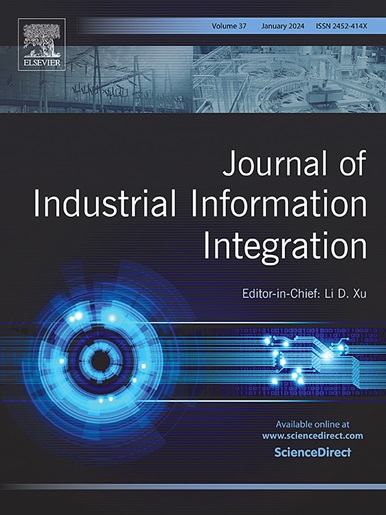Cyber-physical internet spatial-temporal reasoning for production logistics resource recommendation in Industry 4.0
IF 10.4
1区 计算机科学
Q1 COMPUTER SCIENCE, INTERDISCIPLINARY APPLICATIONS
引用次数: 0
Abstract
Production logistics (PL) focuses on planning, allocating, and controlling the material and information flows within production processes. In discrete manufacturing, PL is characterized by significant dynamics and uncertainty due to fluctuating resource demands and operational asynchrony. Reliable PL resource allocation is not only fundamental for improving production efficiency but also serves as a crucial prerequisite for orchestrating various resources to achieve zero inventory or even zero warehousing. Therefore, this paper proposes a recommendation-based PL resource allocation approach that considers the temporal and spatial characteristics of shop floors and production materials. To accurately represent the relationships of various entities and resource allocation history, we borrow the idea from the digital Internet, where the IP address and routing tables contribute to moving data packets, to design the Cyber-Physical Internet (CPI) addresses and routing tables, which represent location areas and resource flow directions, and thereby construct the resource spatial-temporal knowledge graph (RSTKG). Then, a spatial-temporal reasoning mechanism is proposed, which conducts connectivity, contextual, and collaborative reasoning on RSTKG to evaluate the cost-effectiveness between required nodes and available resources and generate the resource allocation recommendation plan. Finally, the allocation decisions will be updated to the related routing table of each node. When new resources arrive, table lookup can be conducted to understand the next transfer direction, reducing the risk of delay during the actual transportation of resources. To evaluate the effectiveness of the proposed approach, we first conduct a laboratory experiment and then conduct a case study on an air conditioning manufacturer. Compared to other resource allocation algorithms, our approach achieves a punctuality rate of over 90%, reduces the average traveling distance, and improves the efficiency of traceability analysis.
工业4.0下生产物流资源推荐的信息物理互联网时空推理
生产物流(PL)侧重于计划、分配和控制生产过程中的物料和信息流。在离散制造中,由于资源需求波动和操作异步,物流具有显著的动态性和不确定性。可靠的物流资源分配不仅是提高生产效率的基础,也是协调各种资源以实现零库存甚至零仓储的关键先决条件。因此,本文提出了一种基于推荐的物流资源分配方法,该方法考虑了车间和生产材料的时空特征。为了准确地表示各种实体之间的关系和资源分配历史,我们借鉴了数字互联网中IP地址和路由表对数据包移动的贡献,设计了代表位置区域和资源流向的网络物理互联网(Cyber-Physical Internet, CPI)地址和路由表,从而构建了资源时空知识图(RSTKG)。然后,提出一种时空推理机制,对RSTKG进行连通性推理、上下文推理和协同推理,评估所需节点与可用资源之间的成本效益,生成资源分配推荐方案。最后,将分配决策更新到每个节点的相关路由表中。当新资源到达时,可以进行表查找以了解下一个传输方向,从而减少资源实际运输过程中的延迟风险。为了评估所提出方法的有效性,我们首先进行了实验室实验,然后对一家空调制造商进行了案例研究。与其他资源分配算法相比,我们的方法实现了90%以上的正点率,减少了平均行驶距离,提高了可追溯性分析的效率。
本文章由计算机程序翻译,如有差异,请以英文原文为准。
求助全文
约1分钟内获得全文
求助全文
来源期刊

Journal of Industrial Information Integration
Decision Sciences-Information Systems and Management
CiteScore
22.30
自引率
13.40%
发文量
100
期刊介绍:
The Journal of Industrial Information Integration focuses on the industry's transition towards industrial integration and informatization, covering not only hardware and software but also information integration. It serves as a platform for promoting advances in industrial information integration, addressing challenges, issues, and solutions in an interdisciplinary forum for researchers, practitioners, and policy makers.
The Journal of Industrial Information Integration welcomes papers on foundational, technical, and practical aspects of industrial information integration, emphasizing the complex and cross-disciplinary topics that arise in industrial integration. Techniques from mathematical science, computer science, computer engineering, electrical and electronic engineering, manufacturing engineering, and engineering management are crucial in this context.
 求助内容:
求助内容: 应助结果提醒方式:
应助结果提醒方式:


